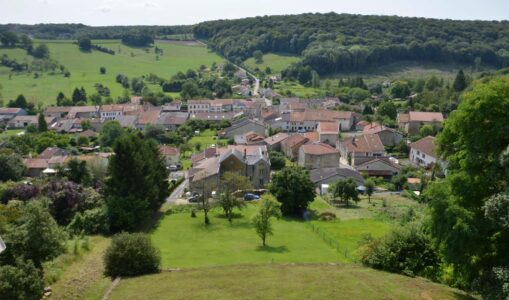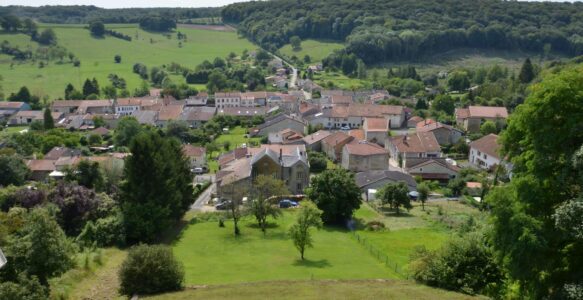Translated by deepl.com

In Mont-devant-Sassey, the beginning of the 20th century proved to be calamitous.
The Farnier family was swept away by influenza and the bell foundry closed in 1908. The vines disappeared, decimated by phylloxera: they were never replanted because the men who had left for the war never returned. The mill and the sawmill stopped.
The village is in the combat zone which will last 4 years: it is the terrible battlefield of Verdun. Mont and the surrounding villages will suffer fighting and destruction from the end of August 1914
On 30 and 31 August 1914, the fighting in Mont-devant-Sassey and Montigny was one of the most violent in the Meuse. Many members of the Joinville fencing and gymnastics school took part and lost their lives…
On 31 August, the French 124th Infantry Regiment faced a regiment of the future Field Marshal Rommel in Mont Wood, behind the church: men from both sides died to the last. The villagers found their bodies and buried the 22 French and 23 Germans together, now equal in death. The remains were transferred to military cemeteries after the end of the war.
A monument still stands on the spot where the villagers had set up the temporary burial ground. It can be reached by a small path that leads up into the forest above the old cemetery. In 2003, a group of Belgian scouts from the 95th Saint-Henri Unit came to participate in the restoration of the building and the site with the friends of the church of Mont and volunteers from the village: work of memory to build together the Europe of tomorrow…
Every year, on 11 November, at the foot of this monument, tribute is paid to the victims of the First World War, and particularly to those of 31 August 1914.
But there are stone monuments… and others. For the war also claimed a civilian victim in Mont-devant-Sassey, long after the Armistice was signed.
At the corner of the church porch still stands a chestnut tree that is more than a hundred years old. It could have been cut down a long time ago because it is deformed and torn apart, but the tree is a kind of “historical monument”. Indeed, after the First World War and the looting of church bells by the Germans, everyone had to find a system for announcing services. In Mont-devant-Sassey, a hydrogen tube used by the aerosol companies was recovered and hung on the chestnut tree in front of the church, on which an altar boy struck a metal bar to imitate the ringing of the bells.
In 1923, young Eugène Trichot was ringing mass when the charged tube accidentally exploded, killing the 15 year old boy. He was considered a civilian victim of war and a stele was placed at the foot of the chestnut tree which still recalls the trauma experienced in the village.
Eugène’s mother was several months pregnant at the time of the tragedy and the little girl who was born was called Eugénie, in memory of her brother. She has always lived in Mont-devant-Sassey and all the current inhabitants still know her since she only died in 2007.
The story has been told from father to son for several generations and no one imagines that they will ever touch this mutilated chestnut tree, a sort of living memorial that miraculously blooms again each spring…
From 1920 to 1940, reconstruction brought a little prosperity and the village had a bakery, two grocery shops, a café and a school with 40 pupils. But after 1945, the farms, although still prosperous, were abandoned by the children of farmers who had left to seek a better life in the towns. From 329 inhabitants in 1901, the village has been maintained at around 120 people since the 1960s…

